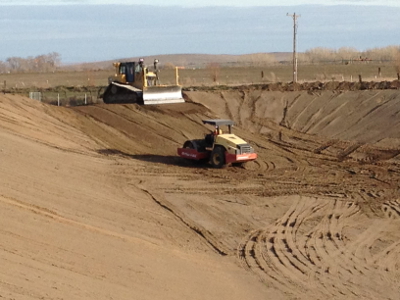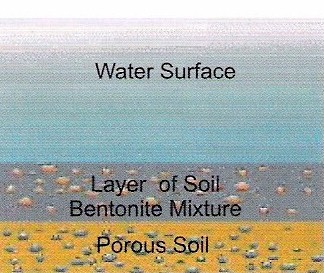
Sealing an earth pond
 Earth ponds are never 100%
water-tight, but it's important to keep the seepage to a minimum
so water levels stay high. As I mentioned in a previous
post, compaction
and gleying are
two traditional methods of creating a (mostly) water-tight seal,
but you can't expect either one to be effective all at once.
A good pond will seep less and less over the course of the first
two years as sediment fills leaks and as the weight of the water
continues to compact the soil.
Earth ponds are never 100%
water-tight, but it's important to keep the seepage to a minimum
so water levels stay high. As I mentioned in a previous
post, compaction
and gleying are
two traditional methods of creating a (mostly) water-tight seal,
but you can't expect either one to be effective all at once.
A good pond will seep less and less over the course of the first
two years as sediment fills leaks and as the weight of the water
continues to compact the soil.
 But what if your
pond's still leaking in year three? Pond remediation often
includes adding native clay or bentonite (the latter of which is a
specific kind of clay) to the soil. To do so, you have to
drain any remaining water out of the pond, mix the additive into
the soil surface, then compact the pond to re-create the
seal. Bentonite generally comes as a powder, so you only
need one pound per square foot of surface, but with clay you'll
need to add a foot or two to create a good seal.
But what if your
pond's still leaking in year three? Pond remediation often
includes adding native clay or bentonite (the latter of which is a
specific kind of clay) to the soil. To do so, you have to
drain any remaining water out of the pond, mix the additive into
the soil surface, then compact the pond to re-create the
seal. Bentonite generally comes as a powder, so you only
need one pound per square foot of surface, but with clay you'll
need to add a foot or two to create a good seal.
If even this fails,
chances are you've picked
a poor site for your pond. In that case, it's best to find a better
location and try again.
| This
post is part of our Earth
Ponds lunchtime series.
Read all of the entries: |
Want more in-depth information? Browse through our books.
Or explore more posts by date or by subject.
About us: Anna Hess and Mark Hamilton spent over a decade living self-sufficiently in the mountains of Virginia before moving north to start over from scratch in the foothills of Ohio. They've experimented with permaculture, no-till gardening, trailersteading, home-based microbusinesses and much more, writing about their adventures in both blogs and books.
Want to be notified when new comments are posted on this page? Click on the RSS button after you add a comment to subscribe to the comment feed, or simply check the box beside "email replies to me" while writing your comment.
